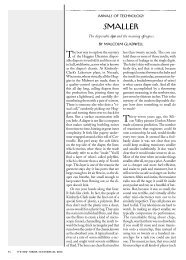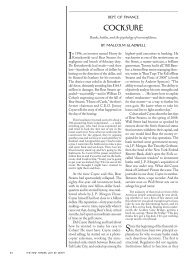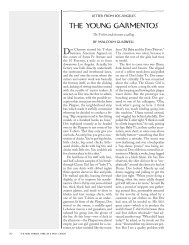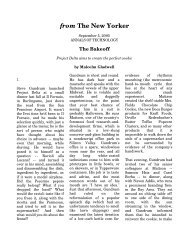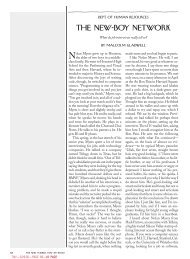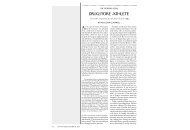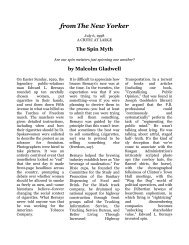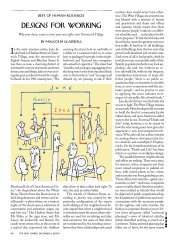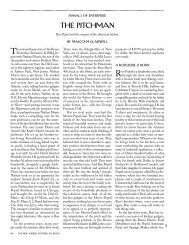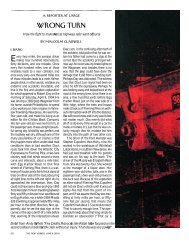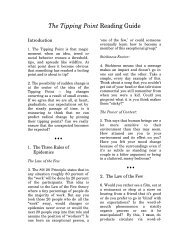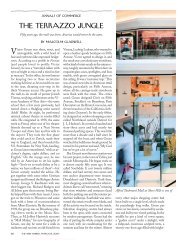iN THE AiR - Malcolm Gladwell
iN THE AiR - Malcolm Gladwell
iN THE AiR - Malcolm Gladwell
You also want an ePaper? Increase the reach of your titles
YUMPU automatically turns print PDFs into web optimized ePapers that Google loves.
do. The genius is not a unique source of<br />
insight; he is merely an efficient source of<br />
insight. “Consider the case of Kelvin, by<br />
way of illustration,” Merton writes, summarizing<br />
work he had done with his Columbia<br />
colleague Elinor Barber:<br />
After examining some 400 of his 661 scientific<br />
communications and addresses . . . Dr.<br />
Elinor Barber and I find him testifying to at<br />
least 32 multiple discoveries in which he<br />
eventually found that his independent<br />
discoveries had also<br />
been made by others. These 32<br />
multiples involved an aggregate<br />
of 30 other scientists, some, like<br />
Stokes, Green, Helmholtz, Cavendish,<br />
Clausius, Poincaré, Rayleigh,<br />
themselves men of undeniable<br />
genius, others, like Hankel,<br />
Pfaff, Homer Lane, Varley and<br />
Lamé, being men of talent, no<br />
doubt, but still not of the highest<br />
order. . . . For the hypothesis that<br />
each of these discoveries was<br />
destined to find expression, even<br />
if the genius of Kelvin had not obtained, there<br />
is the best of traditional proof: each was in<br />
fact made by others. Yet Kelvin’s stature as<br />
a genius remains undiminished. For it required<br />
a considerable number of others to<br />
duplicate these 32 discoveries which Kelvin<br />
himself made.<br />
This is, surely, what an invention session<br />
is: it is Hankel, Pfaff, Homer Lane,<br />
Varley, and Lamé in a room together,<br />
and if you have them on your staff you<br />
can get a big chunk of Kelvin’s discoveries,<br />
without ever needing to have Kelvin—which<br />
is fortunate, because, although<br />
there are plenty of Homer Lanes,<br />
Varleys, and Pfaffs in the world, there are<br />
very few Kelvins.<br />
Merton’s observation about scientific<br />
geniuses is clearly not true of artistic geniuses,<br />
however. You can’t pool the talents<br />
of a dozen Salieris and get Mozart’s<br />
Requiem. You can’t put together a committee<br />
of really talented art students and<br />
get Matisse’s “La Danse.” A work of artistic<br />
genius is singular, and all the arguments<br />
over calculus, the accusations back<br />
and forth between the Bell and the Gray<br />
camps, and our persistent inability to<br />
come to terms with the existence of multiples<br />
are the result of our misplaced desire<br />
to impose the paradigm of artistic invention<br />
on a world where it doesn’t<br />
belong. Shakespeare owned Hamlet because<br />
he created him, as none other before<br />
or since could. Alexander Graham<br />
Bell owned the telephone only because<br />
his patent application landed on the examiner’s<br />
desk a few hours before Gray’s.<br />
The first kind of creation was sui generis;<br />
60 <strong>THE</strong> NEW YORKER, MAY 12, 2008<br />
the second could be re-created in a warehouse<br />
outside Seattle.<br />
This is a confusing distinction, because<br />
we use the same words to describe<br />
both kinds of inventors, and the brilliant<br />
scientist is every bit as dazzling in person<br />
as the brilliant playwright. The unavoidable<br />
first response to Myhrvold and his<br />
crew is to think of them as a kind of<br />
dream team, but, of course, the fact that<br />
they invent as prodigiously<br />
and effortlessly as they do is<br />
evidence that they are not<br />
a dream team at all. You<br />
could put together an Intellectual<br />
Ventures in Los Angeles,<br />
if you wanted to, and<br />
Chicago, and New York and<br />
Baltimore, and anywhere<br />
you could find enough imagination,<br />
a fresh set of eyes,<br />
and a room full of Varleys and Pfaffs.<br />
The statistician Stephen Stigler once<br />
wrote an elegant essay about the futility<br />
of the practice of eponymy in science—that<br />
is, the practice of naming<br />
a scientific discovery after its inventor.<br />
That’s another idea inappropriately<br />
borrowed from the cultural realm. As<br />
Stigler pointed out, “It can be found<br />
that Laplace employed Fourier Transforms<br />
in print before Fourier published<br />
on the topic, that Lagrange presented<br />
Laplace Transforms before Laplace<br />
began his scientific career, that Poisson<br />
published the Cauchy distribution in<br />
1824, twenty-nine years before Cauchy<br />
touched on it in an incidental manner,<br />
and that Bienaymé stated and proved<br />
the Chebychev Inequality a decade<br />
before and in greater generality than<br />
Chebychev’s first work on the topic.”<br />
For that matter, the Pythagorean theorem<br />
was known before Pythagoras;<br />
Gauss ian distributions were not discovered<br />
by Gauss. The examples were<br />
so legion that Stigler declared the existence<br />
of Stigler’s Law: “No scienti-<br />
fic discovery is named after its original<br />
discoverer.” There are just too many<br />
people with an equal shot at those<br />
ideas floating out there in the ether.<br />
We think we’re pinning medals on heroes.<br />
In fact, we’re pinning tails on<br />
donkeys.<br />
Stigler’s Law was true, Stigler gleefully<br />
pointed out, even of Stigler’s Law itself.<br />
The idea that credit does not align<br />
with discovery, he reveals at the very end<br />
of his essay, was in fact first put forth by<br />
Merton. “We may expect,” Stigler concluded,<br />
“that in years to come, Robert K.<br />
Merton, and his colleagues and students,<br />
will provide us with answers to these and<br />
other questions regarding eponymy,<br />
completing what, but for the Law, would<br />
be called the Merton Theory of the reward<br />
system of science.”<br />
In April, Lowell Wood was on the<br />
East Coast for a meeting of the Hertz<br />
Foundation fellows in Woods Hole.<br />
Afterward, he came to New York to<br />
make a pilgrimage to the American<br />
Museum of Natural History. He had<br />
just half a day, so he began right away in<br />
the Dinosaur Halls. He spent what he<br />
later described as a “ridiculously prolonged”<br />
period of time at the first station<br />
in the Ornithischian Hall—the ankylosaurus<br />
shrine. He knew it by heart. His<br />
next stop was the dimetrodon, the progenitor<br />
of Mammalia. This was a family<br />
tradition. When Wood first took his<br />
daughter to the museum, she dubbed<br />
the fossil “Great Grand-Uncle Dimetrodon,”<br />
and they always paid their respects<br />
to it. Next, he visited a glyptodont;<br />
this creature was the only truly<br />
armored mammal, a fact of great significance<br />
to a former weaponeer.<br />
He then wandered into the Vertebrate<br />
Origins gallery and, for the hundredth<br />
time, wondered about the strange<br />
openings that Archosauria had in front<br />
of their eyes and behind their nostrils.<br />
They had to be for breathing, didn’t<br />
they? He tried to come up with an alternate<br />
hypothesis, and couldn’t—but<br />
then he couldn’t come up with a way<br />
to confirm his own hunch, either. It was<br />
a puzzle. Perhaps someday he would<br />
figure it out. Perhaps someone else<br />
would. Or perhaps someone would find<br />
another skeleton that shed light on<br />
the mystery. Nathan Myhrvold and Jack<br />
Horner had branched out from Montana,<br />
and at the end of the summer were<br />
going to Mongolia, to hunt in the Gobi<br />
desert. There were a lot more bones<br />
where these came from. apple<br />
1<br />
From the Times.<br />
“These letters are a smoking gun that something<br />
is not right in Denmark,” Judge Agresti<br />
said in a Dec. 20 hearing in Pittsburgh.<br />
Downright rotten, we’d say.



